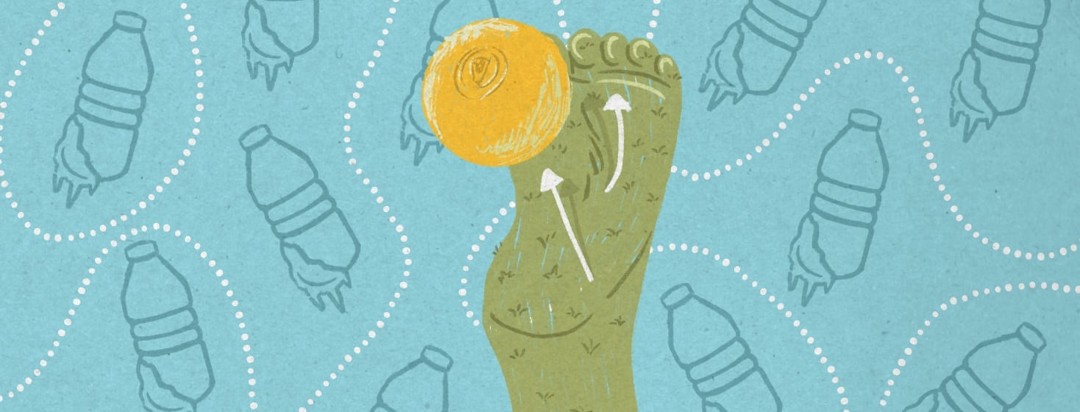RA and Plantar Fascitis: What Do Lacrosse Balls and Bottles of Ice Have in Common?
Ever since I was in my 20s, I’ve always enjoyed a really good foot massage. Not just a light-handed rubbing of the skin, but a massage with pressure that digs deep into the tissue.
Foot pain related to fallen arches
Around the time I was diagnosed with rheumatoid arthritis (RA), I was also seeking care from a podiatrist for feet that had begun to hurt like crazy. After examination and x-rays, the explanation for the pain provided by the doctor was fallen arches. I had always had very high arches in my feet, so this was a surprise to me.
My podiatrist explained that rheumatoid arthritis can cause inflammation in the small joints of the feet and weaken the ligaments in the feet, ultimately leading to the fallen arches.
The immediate treatment she provided was a stiff support of specialized taping applied to the bottom and around the sides of the feet. Seemingly indestructible, the porous tape lasted for weeks as I dried it with a hairdryer after each shower. The doctor told me that the tape would begin to come off on its own when the adhesive wore off.
Taping my arches for support
At first, the pressure provided by the taping technique was quite uncomfortable. It felt strange and made me leery of putting pressure on my feet. But after a few days, my feet really seemed to crave the feeling of being super supported and walking didn’t hurt nearly as much.
After the tape started to come loose on its own accord, my podiatrist repeated the taping procedure. After the second taping came off, my doctor created casts of my feet and ordered custom-made orthotics for my shoes.
What is plantar fasciitis?
The support provided by the tape allowed the tissues within my feet to begin to heal. What I didn’t know at the time was that this process allowed the plantar fascia — the fibrous tissue that runs along the bottom of the foot — to become less inflamed. It was never mentioned that I had plantar fasciitis in addition to fallen arches.1
Plantar fasciitis can be a very painful condition where the thick band of tissue that runs along the length of the foot becomes inflamed. This inflammation can cause severe pain, including heel pain that might be worse in the mornings.1
Treating plantar fasciitis
Treatments range from physical therapy (particularly stretching of the bottoms of the feet and the calf muscles) and shoe orthotics to steroid injections or surgery.2
Exercise and stretches
My podiatrist didn’t mention that exercise could be one way to prevent future occurrences of the pain I experienced. We were more focused on allowing the tissue to recover.
I do recall that the doctor suggested that eventually, I could try things like rolling the bottom of each foot over a frozen bottle of water for temporary relief.
Rolling ice bottles
Rolling ice bottles under the feet feel good, but it seems to aggravate my Raynaud’s syndrome. Manually stretching and massaging the bottom of my feet feels good but doesn’t quite get into the tissue as much as I’d like and I’ve always liked when it comes to foot massages.
Lacrosse balls
I recently asked for lacrosse balls as a gift. Yahoo, now we’re talkin’! Lacrosse balls are harder than tennis balls and don’t cave so much under pressure. Now I can roll my foot over the hard ball and really dig into the arch of my foot.
I like to make sure that I roll the lacrosse ball all the way from the ball of my foot beneath each toe to the corresponding position on the heel of my foot. This combined with calf stretches has given me happy feet.
Simple things make a huge difference
Relaxed, flexible feet seem to contribute to a more relaxed and flexible body. Sometimes it’s the simple things we can do for ourselves that make a huge difference. Simple stretches, soda bottles repurposed for foot ice massages, and stiff lacrosse balls that fit the natural curve of your foot are simple tools that can help manage foot pain.
If you experience pain in the bottom of the feet, please talk to your rheumatologist, consult with a podiatrist, and work with a physical therapist to find an approach that works for you.
Do you experience heel pain or pain on the bottoms of your feet? What are ways you’ve managed to relieve the pain or prevent the pain from returning? I’d love to read your stories and suggestions in the comments below.
Be well,
Lisa

Join the conversation